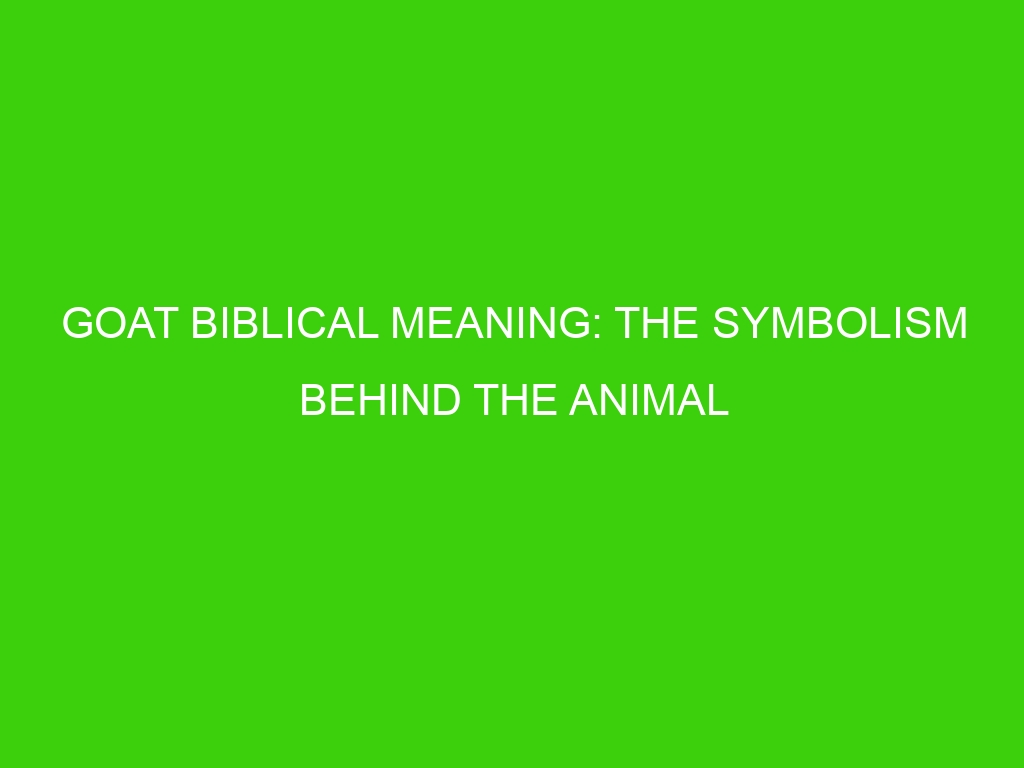You’ve probably heard about goats getting a bad rap over the years as stubborn or devilish creatures.
But did you know that goats actually have deep spiritual symbolism in the Bible and other faiths? Their place in religious texts and imagery is complex and goes way beyond just being sacrificial offerings.
In this article, we’ll explore the layered symbolic meanings behind goats in the Bible and other religions.
You’ll learn about how goats represent both Christ and sinful behavior in Christianity.
We’ll also touch on their links to pagan gods like Pan.
And we’ll uncover why goats are seen as tenacious, determined animals who aren’t afraid to forge their own path.
Whether you’re curious about biblical animals or looking to deepen your understanding of spiritual symbolism, this guide on the goat’s religious and mythological significance will give you plenty of food for thought.
Goats in the Bible: A Brief Overview
Goats were an important part of daily life in ancient Israel, so it’s no surprise they pop up frequently in the Bible.
As symbols of leadership, goats were used in religious ceremonies.
During the Day of Atonement, two goats were chosen – one was sacrificed, the other (the ‘scapegoat’) was released into the wilderness, symbolically carrying the sins of the people with it.
Goats were also seen as stubborn and willful.
In Matthew’s gospel, Jesus separates the ‘sheep’ (the faithful) from the ‘goats’ (the unrighteous).
Goats were independent and liked to wander, just as humans can stray from God’s path.
At the same time, goats provided essential resources.
Their milk, meat, and hair were used for food, clothing, and shelter.
As such, goats were a sign of prosperity and God’s provision.
After the flood, Noah sacrificed some of the goats that had been on the ark.
Several key biblical figures, like Esau and Jacob, were goat herders.
But the most famous goat herder was probably Amos, the prophet.
Amos lived in Tekoa, a village known for raising goats, before being called by God.
His humble background gave him a unique perspective on society and justice.
As you can see, goats held many symbolic meanings in the Bible.
They represented sin and stubbornness, as well as provision and leadership.
Like the complex animals they are, goats remind us of our own contradictions – how we can both stray and be faithful, be willful yet provide for others.
For the ancient Israelites, goats were a mirror into the human soul.
Key Events and Stories Involving Goats in Scripture
The Scapegoat
One of the most well-known references involving goats in the Bible is the scapegoat.
According to Leviticus 16, on the Day of Atonement, two goats were chosen.
One was sacrificed as a sin offering, while the other, the scapegoat, was released into the wilderness after the high priest placed his hands on its head and confessed the sins of the people.
The scapegoat symbolized the removal of sin and guilt from the community.
The Parable of the Sheep and the Goats
In Matthew 25, Jesus tells the parable of the sheep and the goats.
He says that during the last judgment, He will separate the people as a shepherd separates the sheep from the goats.
The sheep, those who showed compassion to others in need, will inherit the kingdom of God.
The goats, those who did not help others, will be condemned.
The parable illustrates how people will be judged based on their treatment of others.
The Goat Idols
In Leviticus 17, God instructs the Israelites not to sacrifice to “goat idols.” This refers to the goat demons or idols worshipped at the time, like Azazel.
God wanted His people to worship Him alone.
The goat idols represent the pagan gods and practices God wanted the Israelites to reject.
As you can see, goats and references to goats appear throughout Scripture, from the scapegoat to the sheep and goats parable to the goat idols.
Goats were commonly kept livestock and used for both sacrifice and symbolism in biblical times.
Their frequent appearance highlights their importance in ancient Israelite culture and religion.
Next time you read your Bible, keep an eye out for these meaningful goat references!
Positive Symbolism and Meaning of Goats in the Bible
Goats were an important part of life in ancient Israel and are mentioned frequently in the Bible.
They represent provision, sacrifice, and leadership.
Provision and Sustenance
Goats provided milk, meat, hair, and hides that were essential for survival.
As such, they symbolize God’s provision and sustenance.
The Bible speaks of goats as a blessing from God and a source of wealth.
The goat is even used in Scripture to represent faithful and productive people who provide benefit to others.
Sacrifice and Atonement
Goats were used as sin offerings in ancient Israel to atone for the people’s sins and purify the tabernacle.
The scapegoat, in particular, symbolized the removal of sin and guilt.
On the Day of Atonement, the high priest would lay his hands on the head of a goat and confess the sins of the people.
The goat would then be released into the wilderness, representing the removal of sin from the people.
Jesus is compared to this scapegoat, as He bore the sins of the world and removed our guilt.
Leadership
In the Bible, goats are also used to symbolize leadership and authority.
In Daniel’s vision of the end times, a goat with a prominent horn represented Greece conquering the Medes and Persians.
In Zechariah, four horns that scattered Judah were said to be the horns of the nations that defeated Israel.
The four horns were then said to be terrified by four blacksmiths, representing deliverers who would overthrow Israel’s enemies.
The Bible employs the familiar imagery of goats to represent God’s blessings, the removal of sin through sacrifice, and the defeat of those who oppose God’s people.
Goats were a vital part of the everyday lives of the ancient Israelites, so using them as symbols helped bring spiritual truths to life.
Negative Connotations and Associations of Goats in Scripture
Goats were often seen in a negative light in the Bible and were associated with sin, wickedness and evil.
Their independent and stubborn nature meant they were seen as defiant creatures who strayed from the herd – much like humanity straying from God.
Sin and Impurity
Goats were used as sin offerings in ancient Israel to atone for unintentional sins and impurities.
Sending a goat into the wilderness, symbolically taking the sins of the people with it, highlights how goats were connected to sin and impurity.
Stubborn and Rebellious
Goats are notoriously stubborn, difficult to herd, and like to stray from the group.
In the Bible, goats are often used as a metaphor for those who rebel against God and ignore his teachings.
For example, in Matthew 25 Jesus separates the “sheep” (the righteous) from the “goats” (the unrighteous) who failed to help others in need.
Associated with the Devil
Goats are associated with evil and the Devil in some interpretations.
In Leviticus 16, two goats were chosen for a sin offering – one was sacrificed, while the other (the ‘scapegoat’) was sent into the wilderness, symbolically carrying the sins of the people.
Some believe this represents good (Jesus) triumphing over evil (the Devil).
Goats were also thought to have a foul odor and were linked to pagan idol worship, furthering their sinister image.
While goats do have some negative biblical symbolism, they were also valued for their milk, meat, and hair.
Their independent and spirited nature is not wholly bad.
The Bible uses metaphorical goat and sheep language to represent good and evil in all of us and encourage us to follow the righteous path.
Overall, goats remind us of our own tendencies towards sin and rebellion and our need for salvation.
The Enduring Legacy of Goats as Biblical Symbols
Goats have played an important role in human history, culture, and religion.
In the Bible, goats symbolize both good and evil.
They represent Jesus as the “Lamb of God” but also the damned during the Last Judgment.
The Scapegoat
In Leviticus 16, God instructs the Israelites to choose a goat to act as a scapegoat to carry away the sins of the people.
The high priest placed his hands on the goat and confessed the people’s sins, symbolically transferring them to the animal.
The goat was then released into the wilderness, representing the removal of sin from the community.
This ritual foreshadowed Jesus as the ultimate sacrifice for sin.
The Good Shepherd
Jesus commonly used the metaphor of a shepherd and his sheep to represent the relationship between God and his followers.
Sheep and goat herding were common occupations, so Jesus’ audience understood this imagery.
In John 10, Jesus says, “I am the good shepherd.
The good shepherd lays down his life for the sheep.” Here, Jesus positions himself as the protector and savior of his flock, symbolizing his sacrificial role.
The Last Judgment
In Matthew 25, Jesus tells a parable of dividing people into sheep and goats during the final judgment.
The sheep, representing the righteous, will inherit the kingdom of God.
The goats, symbolizing the unrighteous, will be cursed into eternal punishment.
Goats were associated with unclean animals, so they were a natural metaphor for sin and condemnation.
Goats feature prominently throughout the Bible, representing both good and evil, sacrifice and sin.
Their complex symbolism reflects the moral tensions in Scripture and the human experience.
The goat ultimately signifies our need for a savior to bear our sins and lead us to salvation.



